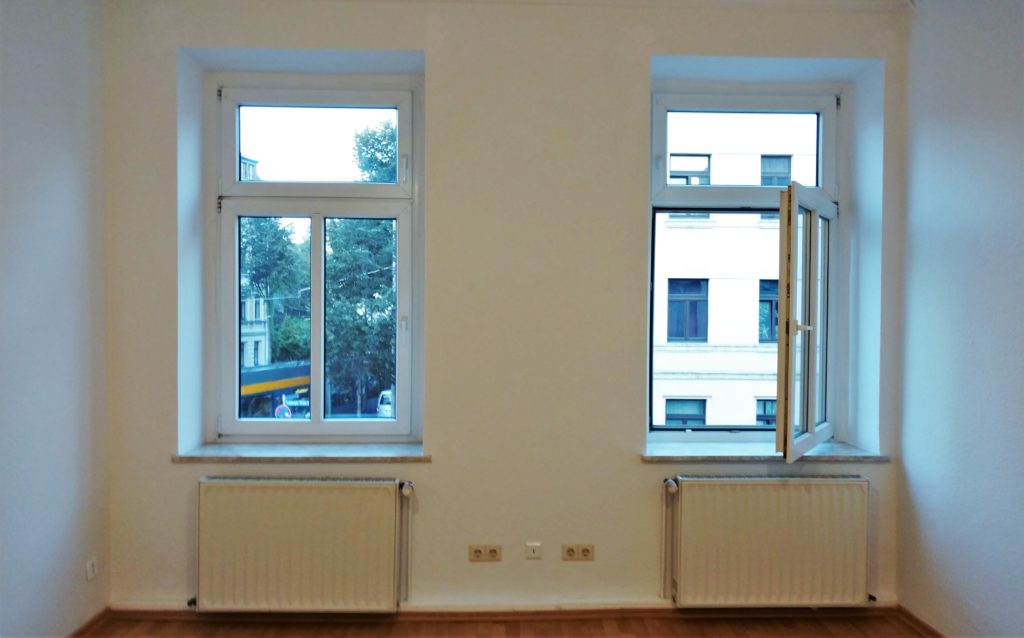A Nifty German Idea: Drehkippfenster Posted by Sten on Jul 24, 2020 in Culture
In Germany, it’s the hottest time of the year right now. With temperatures up to and sometimes even surpassing 30°C (86°F), there is a real need for frische Luft (fresh air)! A genius German invention that makes this quite easy is the Dreh-Kipp-Fenster (tilt-and-turn window). Americans rave about these Fenster and how amazing they are – so let’s find out what’s so special about them!
What is a Dreh-Kipp-Fenster?
Invented in the 1950s in Germany, the Dreh-Kipp-Fenster is a favourite all over Europe. In the 1950s, the first Dreh-Kipp-Fenster were invented. It allows you to turn the window (drehen) when the handle is turned 90° and to tilt it (kippen) when the handle is turned 180°. While drehen allows you to clean the outside of the window, put your head outside or for short periods of Stoßlüften (inrush airing). Here, you open your windows wide in different places of your home to allow a strong airflow to get fresh air into the home and to avoid mouldy or stale air. It’s recommended to do this every day for about 15 minutes in the morning. In the summer, this is also a nice tip to keep the house relatively cool, as the cool morning air gets “trapped” inside the home.
However, German summers don’t get that hot, so another option to keep airflow constant is the Kippfunktion (tilt functionality). By tilting the window, less air is exchanged, but the effect is also not as dramatic. People sometimes just always leave their windows open like that (I wouldn’t recommend it though).
It makes sense that these windows are popular in more temperate European climates where summers don’t get too hot. Air conditioning is not very common in homes, so good isolation and proper venting methods are handy ways to deal with eventual heat. Also, without air conditioning, homes don’t have a way of moving air between the inside and outside of the home, so windows that are geared towards that task are an advantage!
Dreh-Kipp-Fenster have only become more popular ever since their invention and are not only ubiquitous in Germany, but many countries in Europe, especially in newer houses. They are the most popular kind of window in Germany. And you find them in all shapes and sizes. My parents have a sliding window door that opens to their Terrasse (terrace), and even that door implements the Kipp feature. Yes, you can tilt a 10-foot window that also serves as a sliding door!
Raving about Windows!
People that did not grow up with these Fenster seem to really love them. Here’s Americans raving about them:
Have you used these windows before? What do you think – are these the best windows in the world? Let me know in the comments below!

Build vocabulary, practice pronunciation, and more with Transparent Language Online. Available anytime, anywhere, on any device.





Comments:
Russ Swift:
Best windows ever. Five years in Germany at Bitburg. Also miss the window “rolladens” with strap on inside so one could block out all light.
Sten:
@Russ Swift Rolladen! Yes, awesome stuff. Not sure if they are a German invention. If they are, I’ll write about those next 😀
Alcazar:
@Sten Rollladen to be precise ?
They derived from the french Jalousie, so not a german invention this time.
Sten:
@Alcazar Ah, of course!
Well, if you know of any other (home-related) German inventions, let me know 🙂
JMurphy:
I love these windows! Every time I am in Europe, I just marvel at how smart and efficient they are and lament that we do not have them in the US. I never knew their name so thank you for this post and their backstory.
Adam Weaver:
Been following your blog. Being raised in a culture similiar to Amish. I am a dyed in the wool Pensylvania Dutchman, as you will know is really a currupted version of Schwabisch. I am fluent in what I have come to call “Dutchlish”. Over the years I have rather casually endeavoured to learn mor “real German”. You site has been facinating and educational. Where are you located? US or Germany? Adam
Sten:
@Adam Weaver That’s awesome! we’ve written about Pennsylvania Dutch before here,
I am located in Germany, as are my colleagues 🙂 We are also all of German descent, but have had experiences abroad. I’ve lived in the US for a while, so differences that stand out always fascinate me. Like these windows!
JackK:
As with many things in Germany, a “special” invention. Used the feature many time during my 4 years in Munich. However, I was amazed at the useful things not in Germany. Window screens; self-bleeding radiator valves; hose-end sprayers.
And, of course, in the US these windows would be way too expensive for the American home. As I told my German friends, the US builds homes to last 100 years; in Germany it’s 1000 years.
Sten:
@JackK Yeah, window screens are quite rare… I am not sure about self-bleeding radiator valves, though I’ve seen and used them. And hose-end sprayers are ubiquitous! Perhaps during the time you were there or perhaps in the specific area you were in, those things were rare :/
The expense is a good point! The reasoning here to put money into it is also insulation. A well-insulated home has lower heating and cooling costs, since the temperature inside can be held much better.
Karen H:
I first saw these windows in a youth Hostel in Vienna. I LOVE them. We need them in the USA.